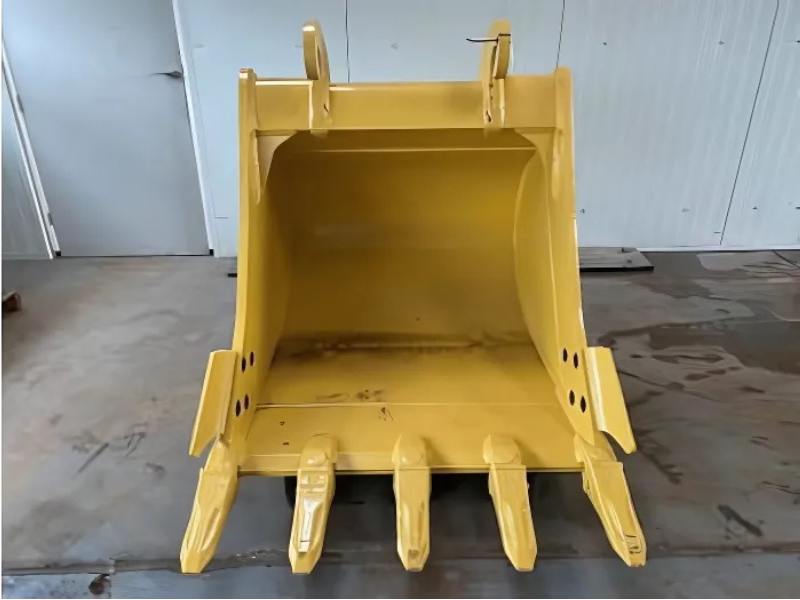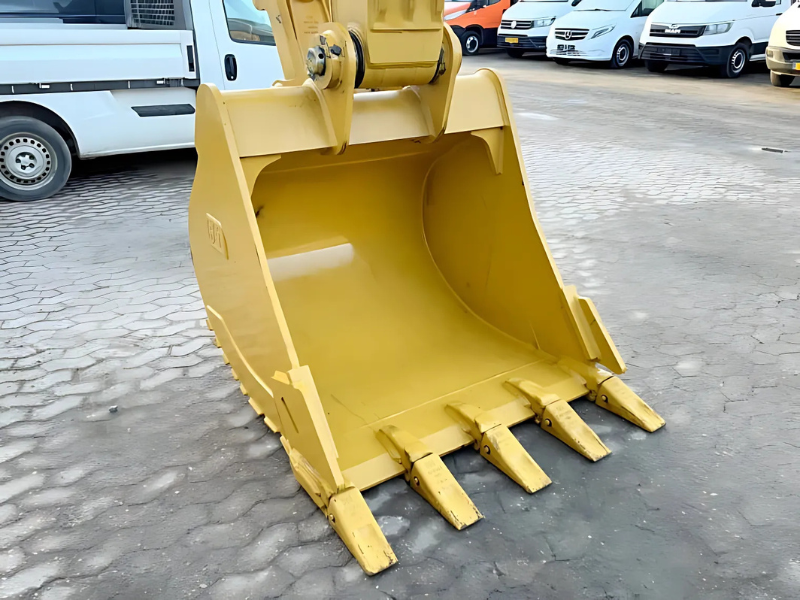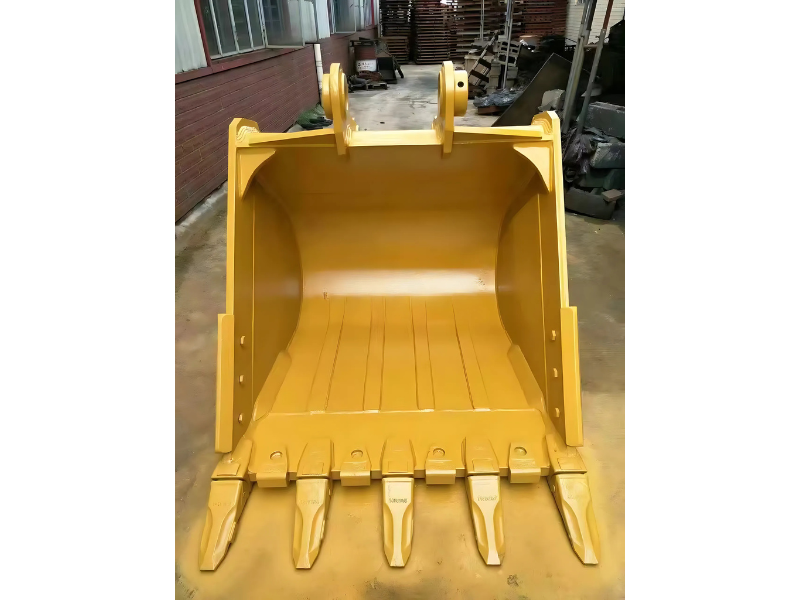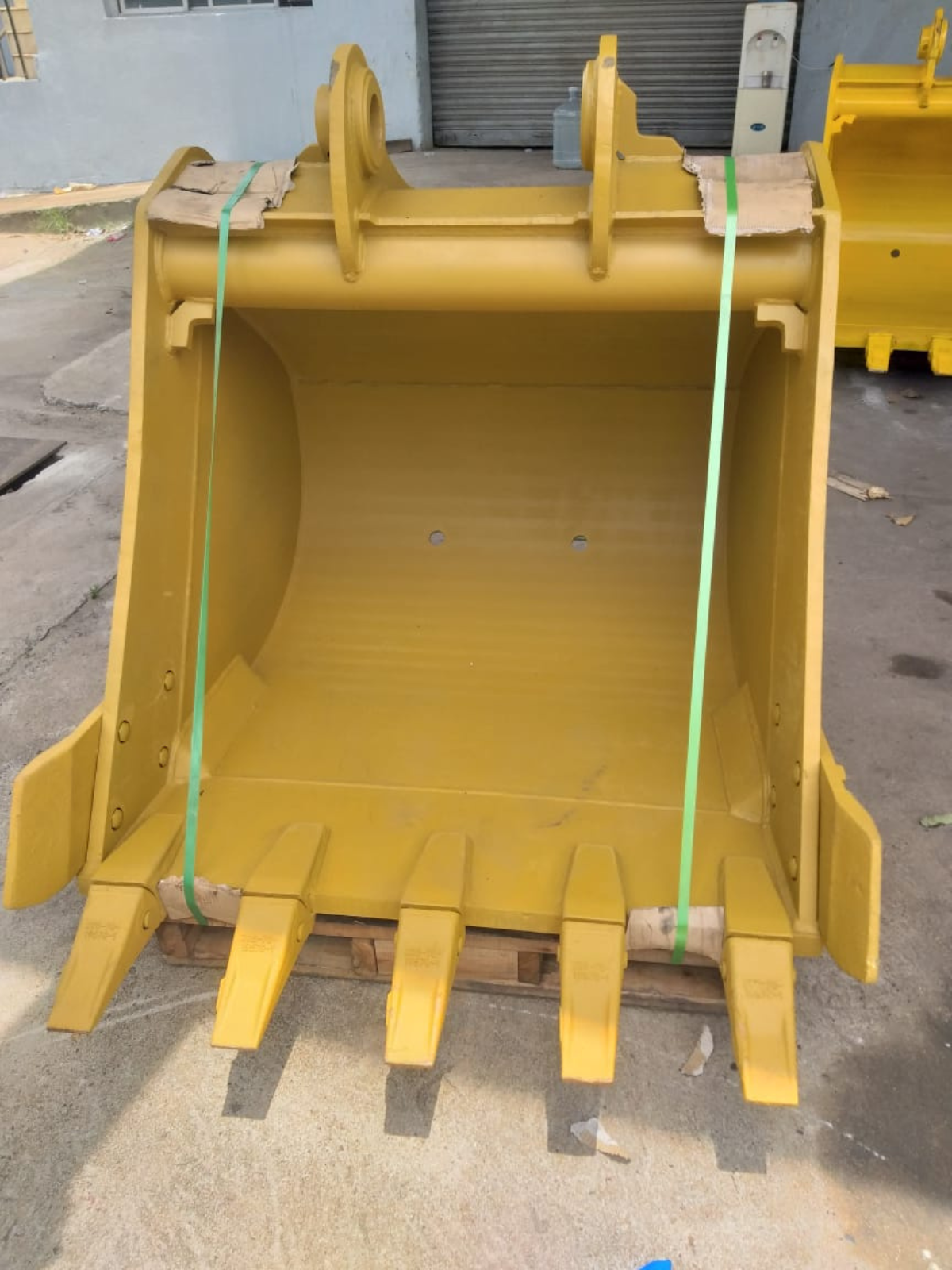
An Excavator Soil Bucket in india is a versatile attachment designed for digging and handling light to medium materials like soil, clay, sand, and topsoil. With its wide shape and efficient design, it ensures smooth scooping, easy filling, and quick dumping for faster operations. Lighter than rock buckets, it offers better digging efficiency, reduced fuel use, and is ideal for tasks such as site prep, trenching, grading, landscaping, and backfilling.
An Excavator Soil Bucket is a standard attachment designed for digging and handling soft ground materials like soil, clay, sand, and topsoil. Unlike heavy-duty rock buckets, it focuses on efficiency and speed in earthmoving tasks.
With a wide, deep design and shorter teeth or a straight edge, the soil bucket allows easy penetration and a high fill factor, enabling operators to move more material in fewer passes. Its light-to-medium duty build reduces stress on the excavator while still providing durability for everyday use.
Commonly used in construction, landscaping, and roadwork, the soil bucket is ideal for digging, trenching, grading, and bulk earthmoving where clean and efficient performance is required.
The Soil Bucket is built for efficient digging, scooping, and handling of light to medium-density materials like soil, clay, and sand.
Optimized Shape – Curved side plates and tapered design ensure smooth penetration, easy filling, and quick material release.
Cutting Edge & Teeth – Reinforced edge with replaceable teeth provides strong breakout force, while optional side cutters protect corners.
Durable Build – Made from high-strength, abrasion-resistant steel with wear plates and corner reinforcements for extended life.
Mounting Options – Compatible with pin-on and quick coupler systems for flexible use across machines.
Balanced Capacity – Designed for efficient loading without over-stressing the excavator.
Protective Finish – Anti-corrosive coating and smooth welds minimize wear and prevent soil sticki

The Soil Bucket is a versatile attachment designed for digging, scooping, and handling light to medium materials.
Key Applications:
Excavation & Trenching: Foundations, basements, utility lines in soft to medium soil.
Loading & Handling: Moving soil, sand, clay, and gravel into trucks or stockpiles.
Backfilling & Levelling: Filling trenches and preparing even ground surfaces.
Agriculture & Landscaping: Soil preparation, clearing, and shaping land profiles.
Utility Projects: Pipeline, drainage, and cable-laying works.
The excavator soil bucket (also called a general-purpose or digging bucket) is the most commonly used excavator attachment.
Design: Flat bottom, moderate sides, curved back for easy loading.
Teeth: Short, blunt teeth for effective soil penetration.
Materials: Handles dirt, clay, sand, gravel, loam, and light frost.
General digging and trenching
Site prep and cleanup
Loading and moving soil or loose materials
Versatile – works in many applications
Cost-effective – less expensive than specialty buckets
Efficient – curved design improves fill and dump cycles
Wears faster in abrasive or rocky ground
Not suitable for precision grading, screening, or heavy rock excavation
Excavator Soil Buckets come in various sizes to suit different machines and jobs:
Mini (200–450 mm): For compact excavators in trenching and small works.
Standard (600–900 mm): Fits mid-size excavators for general construction.
Heavy-Duty (1000–1800 mm): For large machines handling bulk earthmoving.
Custom Sizes: Available for specific project needs.
Machine Compatibility
Buckets are matched to excavator weight class (1–3T, 5–8T, 12–20T, 20–35T+), pin dimensions, and quick coupler systems. They are designed to work with most major brands (Caterpillar, JCB, Komatsu, Volvo, etc.) and align with the machine’s hydraulic power and breakout force for safe, efficient digging.
In short: Choosing the right size and fit ensures faster cycles, lower fuel use, and less wear on your machine.

Choosing the right soil bucket ensures efficiency, durability, and cost savings on-site. Here’s what to consider:
Soil Type: Wide, lightweight buckets for soft soils; reinforced edges and teeth for clay or mixed soils.
Bucket Size: Match capacity to your excavator to avoid strain or reduced output.
Project Needs: Wider buckets for bulk earthmoving; narrower ones for precision trenching or landscaping.
Compatibility: Ensure the bucket fits your excavator’s pin size or quick coupler system.
Design Features: Look for durable cutting edges, optimized shapes, and protective side cutters.
Cost vs. Durability: Standard buckets suit general work, while heavy-duty options are best for demanding conditions.
Excavator soil buckets face constant wear from digging and handling soil. Regular care ensures longer life and better performance.
Inspect Frequently: Check for cracks, loose pins, and worn teeth or cutting edges.
Monitor Wear Parts: Replace bucket teeth, cutting edges, and side cutters before excessive wear damages the bucket.
Lubricate Regularly: Keep pins and bushings greased to avoid play and premature wear.
Clean After Use: Remove packed soil and debris to prevent rust and corrosion.
Operate Correctly: Avoid overloading, side-loading, and aggressive prying that stress the bucket.
Repair Early: Fix cracks with welding and replace wear parts promptly to reduce costly downtime.

Quick couplers make soil buckets more versatile and efficient by enabling fast, safe, and effortless attachment changes.
Faster Changes: Switch between buckets or tools in minutes, reducing downtime.
Versatility: Handle multiple tasks—digging, loading, trenching—with one machine.
Safety: Secure locking systems prevent accidental releases.
Operator Ease: Hydraulic controls allow attachment swaps directly from the cab.
Cost Savings: Fewer machines and less idle time mean lower operating costs.
Quick couplers turn the excavator soil bucket into a flexible, multi-tasking tool that boosts productivity and job site efficiency.
Versatile Use – Suitable for digging, trenching, loading, and backfilling across different soil types.
Efficient Performance – Optimized design ensures smooth digging, higher fill factor, and reduced fuel use.
Durability – Built with high-strength steel and wear-resistant edges for longer life.
Cost-Effective – Low maintenance, fewer replacements, and better ROI.
Quick Attachment – Easy to fit with excavators of different sizes, reducing downtime.
Safe & Reliable – Secure material handling minimizes spillage and improves site safety.
Eco-Friendly – Fewer cycles and less fuel consumption lower the carbon footprint.
Q1. What is the primary use of a soil bucket?
A soil bucket is designed for digging, loading, and transporting loose soils, clay, sand, and other soft materials. It is optimized for maximum fill and efficient material handling.
Q2. How is a soil bucket different from a rock bucket?
A rock bucket is built heavier, with thicker side plates and reinforced edges to handle abrasive and dense materials like rock and concrete. A soil bucket is lighter, wider, and focuses on productivity in softer conditions.
Q3. Can I use a soil bucket for grading work?
Yes, soil buckets often have a wide and smooth profile, making them suitable for light grading, levelling, and backfilling operations.
Q4. How do I choose the right soil bucket size?
The ideal size depends on your excavator’s capacity, job requirements, and the density of the soil. Oversizing may cause stress on hydraulics, while undersizing reduces productivity. Always match the bucket to the machine’s tonnage and working conditions.
Q5. Do soil buckets come with replaceable wear parts?
Yes. Most soil buckets feature replaceable cutting edges, teeth, and sometimes side cutters. This allows operators to extend the bucket’s life and reduce long-term costs.
Q6. What’s the typical lifespan of a soil bucket?
It varies based on usage, soil type, and maintenance. With proper care and replacement of wear parts, a soil bucket can last several years in normal operating conditions.
Q7. Are soil buckets suitable for wet or sticky soils?
Yes, but for extremely sticky or clay-heavy soils, operators may require anti-clogging features or regular cleaning to maintain efficiency.
Q8. Can I attach a soil bucket to other machines like backhoes or loaders?
Some soil buckets are designed specifically for excavators, while others may be adapted for backhoes or skid steers. Compatibility depends on coupler type, pin size, and machine capacity.

Excavator Rock Bucket | Excavator Skeleton Bucket | Excavator Trapezoidal Bucket | Excavator Soil Bucket | Excavator Loader Bucket | Excavator Single-Shank Ripper | Excavator Triple-Shank Ripper | Excavator Track Link Assembly | Excavator Tooth Points | Excavator JCB Teeth & Side Cutter | Excavator Idler | Excavator Sprocket | Excavator Lower Roller | Excavator Undercarriage | Excavator Track Group | Excavator Bolts | Excavator Rock Bucket in Chennai | Excavator Skeleton Bucket in Chennai | Excavator Trapezoidal Bucket in Chennai | Excavator Soil Bucket in Chennai | Excavator Loader Bucket in Chennai | Excavator Single-Shank Ripper in Chennai | Excavator Triple-Shank Ripper in Chennai | Excavator Track Link Assembly in Chennai | Excavator Tooth Points in Chennai | Excavator JCB Teeth & Side Cutter in Chennai | Excavator Idler in Chennai | Excavator Sprocket in Chennai | Excavator Lower Roller in Chennai | Excavator Undercarriage in Chennai | Excavator Track Group in Chennai | Excavator Bolts in Chennai | Excavator Rock Bucket in India | Excavator Skeleton Bucket in India | Excavator Trapezoidal Bucket in India | Excavator Soil Bucket in India | Excavator Loader Bucket in India | Excavator Single-Shank Ripper in India | Excavator Triple-Shank Ripper in India | Excavator Track Link Assembly in India | Excavator Tooth Points in India | Excavator JCB Teeth & Side Cutter in India | Excavator Idler in India | Excavator Sprocket in India | Excavator Lower Roller in India | Excavator Undercarriage in India | Excavator Track Group in India | Excavator Bolts in India
TEAM. All Rights Reserved. Developed by Pixel Tech.